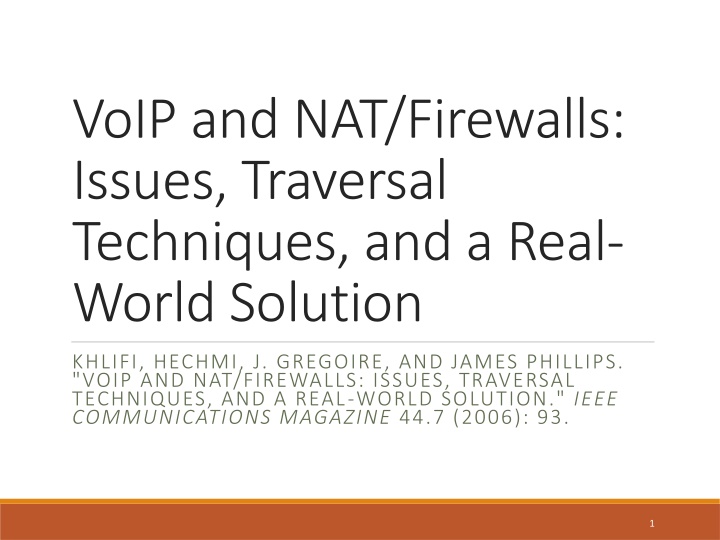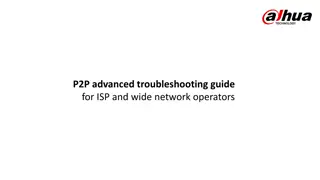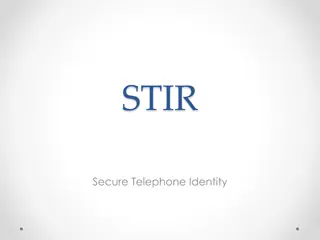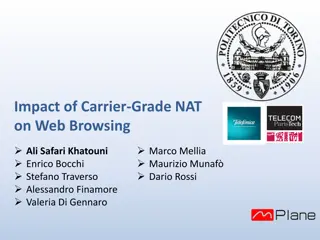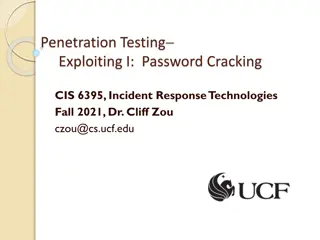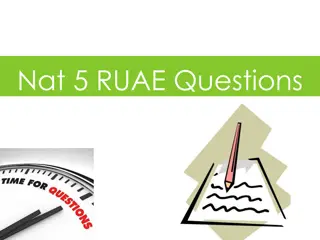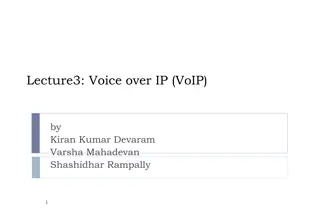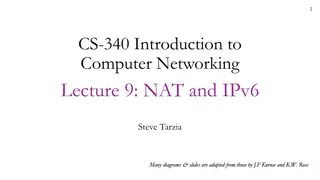VoIP and NAT/Firewalls: Issues, Traversal Techniques
This article delves into the challenges faced by VoIP due to NAT/firewalls, explores traversal techniques, and presents real-world solutions. Topics covered include firewall types, SIP protocol, deployment scenarios, and VoIP NAT/Fs traversal techniques, with a focus on application layer gateways and the MIDCOM protocol.
Download Presentation

Please find below an Image/Link to download the presentation.
The content on the website is provided AS IS for your information and personal use only. It may not be sold, licensed, or shared on other websites without obtaining consent from the author.If you encounter any issues during the download, it is possible that the publisher has removed the file from their server.
You are allowed to download the files provided on this website for personal or commercial use, subject to the condition that they are used lawfully. All files are the property of their respective owners.
The content on the website is provided AS IS for your information and personal use only. It may not be sold, licensed, or shared on other websites without obtaining consent from the author.
E N D
Presentation Transcript
VoIP and NAT/Firewalls: Issues, Traversal Techniques, and a Real- World Solution KHLIFI, HECHMI, J. GREGOIRE, AND JAMES PHILLIPS. "VOIP AND NAT/FIREWALLS: ISSUES, TRAVERSAL TECHNIQUES, AND A REAL-WORLD SOLUTION." IEEE COMMUNICATIONS MAGAZINE 44.7 (2006): 93. 1
Overview Introduction Firewalls and NATs SIP protocol and VoIP Deployment Scenarios VoIP NAT and Firewall Problems VoIP NAT/Fs Traversal Techniques A Real-World solution Conclusion 2
Introduction Existing firewalls and NATs devices prevent VoIP protocols from reaching endpoints Available traversal techniques are either limited or not supported by endpoints 3
Firewalls and NATs Firewall A security agent that protects a private network from the public network to which it is connected NAT An entity that maps a set of IP addresses to another set of IP addresses Four types Full cone Restricted cone Port restricted cone Symmetric NAT/F 4
SIP Protocol and VoIP Deployment Scenarios 3 types of entities User agents: VoIP endpoints Registrars: location servers that keep track of user s locations Proxy servers: forward SIP requests and responses Session Description Protocol(SDP) : describe multimedia sessions Real Time Protocol(RTP) : media transport between endpoints 6
VoIP NAT/Fs Traversal Techniques Application Layer Gateways(ALG), MIDCOM Parse SIP headers and SDP bodies in order to map private IP addresses and ports to public ones Serious limitation of scalability and speed of deployment of new applications Middlebox Communication(MIDCOM) protocol To overcome the limitation of ALG Allow application to control NAT/Fs Network administrators won t accept user applications controlling their firewalls 8
Universal Plug and Play (UPnP) A client can use UPnP to discover the existence of a NAT/F device and ask it to map a particular internal port to an external port Cannot totally rely on UPnP because many user agents and NAT/Fs do not support it 9
Simple Traversal of UDP Through NAT A client/server protocol that allows applications to discover the presence and types of NAT/Fs between them and the public Internet Not support symmetric NAT/Fs 10
Traversal Using Relay NAT (TURN) To resolve VoIP traversal through S NAT/Fs Provide an external address at a TURN server that acts as a relay and guarantees traffic will reach the associated internal address 11
A Real-World Solution Redesigned the SIP registrar/proxy server and developed an RTP relay to reach these objectives Allow any type of user agent, with or without NAT/F capabilities to work with the solution 12
Overviewof the NAT/F Traversal Procedure Detect whether it is private or public. If it is private, detect the public IP address and type of NAT/F that separates it from the public Internet. Regularly probe the STUN server to update the public address. This resolves the frequent situation where the Internet service provider (ISP) dynamically changes the public IP address it gives to its customer. 13
Overviewof the NAT/F Traversal Procedure (cont.) For each received REGISTER request, detect the existence of a NAT/F that separates the client from the server. Put this information in the database. If a registered client is behind a NAT/F, keep sending OPTIONS requests to it in order to keep the listening port open in its NAT/F. For each received INVITE request, detect the existence of a NAT/F that separates the client from the public Internet. If the tow clients are behind NAT/Fs, the server uses the RTP relay to traverse the NAT 14
Use of the RTP Relay RTP relay is used to ensure that media streams successfully traverse a NAT/F Use Media Control Protocol (MCP) to coordinate with proxy server and the RTP relay 15
Media Control Protocol (MCP) Three messages : ALLOCATE, CONNECT, STOP ALLOCATE asks the RTP relay to allocate the resources to a new media session CONNECT asks the RTP relay to relay the RTP streams between two clients STOP asks the RTP relay to stop an ongoing session 16
Procedurefor NAT/F traversal using the RTP relay 1. The caller sends a SIP INVITE to the proxy server 2. The proxy server sends an ALLOCATE request to the RTP relay containing the SDP body of the INVITE 3. If RTP relay response OK, a new SDP body is sent to the proxy server 4. The proxy forwards the INVITE message to the second client after replacing the SDP body by the new one 5. After receiv- ing the INVITE, the called client answers with an OK message (SIP message). 17
Procedurefor NAT/F traversal using the RTP relay (cont.) 6. The proxy server sends a CONNECT message to the RTP relay using the SDP contained in the OK message 7. At the reception of the response from the RTP server, the proxy forwards the SIP OK message to the caller using the new SDP body 8. At this stage the two clients are able to send their RTP packets to the RTP relay, and the RTP relay is ready to start forwarding packets between them 9. The proxy server sends a STOP message to the RTP relay 18
Advantages of the Solution It s designed to be used by SIP servers Reduce the administrative burden as only servers RTP relay is able to understand the SDP protocol. It makes it support advanced VoIP services such as media transcoding, conversation recordings, call monitoring 19
Conclusion They have presented a solution to allow available user agents to operate behind NAT/Fs in spite of their limitations All current possible solutions for symmetric NAT/F traversal require the deployment of a public server. The server may be the target of dos attacks From a long-term perspective, ALG and MIDCOM seem to be the best solutions as they avoid exposing VoIP servers to public threats 20
